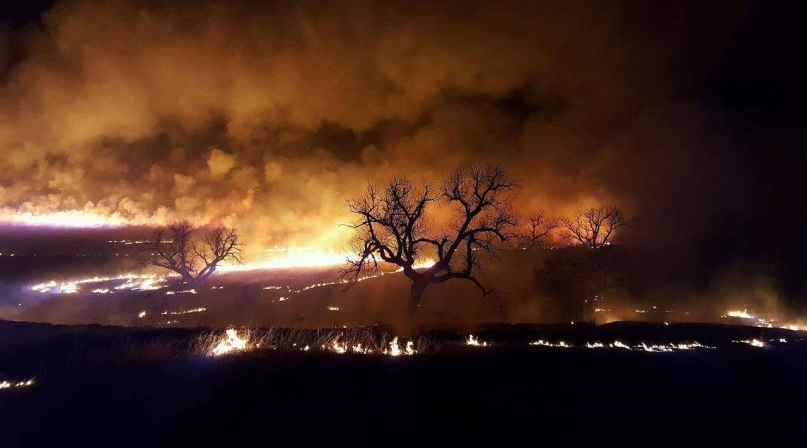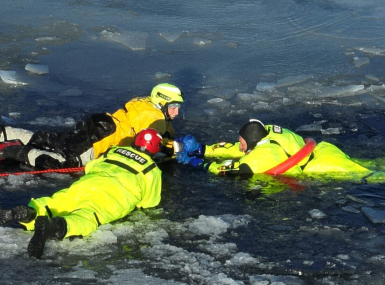Wildfires ravage 1 million acres

Early March wildfires killed seven people in five counties in Texas, Colorado, Oklahoma and Kansas
Deadly wildfires whipped by dry conditions, low humidity and high winds over several days, first reported March 6, killed seven people in five counties in Texas, Colorado, Oklahoma and Kansas.
In Texas, the largest of the blazes was spread across 400,000 acres in Lipscomb, Ochiltree and Gray counties, in the Texas Panhandle.
Lipscomb County Judge Willis Smith was monitoring reports about the fire March 6 from the regional planning commission when he realized the county might be in trouble. “The wind was blowing something awful that day,” he said. His secretary stepped outside the courthouse that afternoon and could see a plume of smoke high up in the air, about 25 miles from town. Smith walked the 40 to 50 feet to the sheriff’s office, and began fielding calls to and from volunteers, residents and the media.
A few hours later, at about 7 p.m., he and the sheriff decided to evacuate Higgins, a small town of about 400 in the county, in the direct path of the fire. They contacted the regional planning commission, which sent out the evacuation order by text and robo-call, telling residents to head east to a shelter in Oklahoma. Winds changed course just before the fire got to Higgins and “saved that little town,” Smith said. He estimated that if the fire had stayed on course just five more minutes, “half that town would have been gone.”
Emily Nolte gets out evacuation orders as the regional preparedness planner at the Panhandle Regional Planning Commission. She gathers and dispenses information from sheriffs, emergency management coordinators and judges as well as the National Weather Service in Amarillo, which uses satellites to monitor fires and their direction. The Panhandle Regional Planning Commission is a voluntary association of cities, counties and special districts in the Texas Panhandle.
Smith said Lipscomb County was short firefighters from their five volunteer fire departments, which use Army surplus trucks, after some had been dispatched earlier to nearby counties fighting fires in Oklahoma.
A local resident died in Lipscomb County in the fire that night. “He was coming home from work,” Smith said. His body was found 300 to 400 yards from his vehicle early the next morning, at about 2 a.m., Smith said. “People think they can drive through it [smoke and fire]. Your vehicle can die. You don’t want to fool with Mother Nature.”
The Texas Panhandle fires also spread to Hemphill and Roberts counties. The latest total, provided March 7 by the Texas A&M Forest Service, showed 478,935 acres had burned in the Texas fires.
Volunteer firefighters got help from the Texas A&M Forest Service and the Department of Public Safety. At least five firefighters in Texas were injured, two critically. In Ochiltree County, about 500 hogs died and several homes were burned, Ochiltree County Sheriff Terry Bouchard said. Thousands of farm animals and wildlife also perished in the fires across the four states.
FEMA approved Fire Management Assistance Grants for seven wildfires in Kansas and one in Oklahoma to help cover costs of staffing, equipment and emergency work, according to a FEMA spokesperson.
Oklahoma
Across the border in Oklahoma, Beaver County Commissioner Brad Raven said the county’s emergency management director interrupted a meeting the morning of March 6 to let them know about a large grass fire burning in the county.
Raven started dispatching graders from county yards, as well as county water trucks, to the scene. The graders created berms in hopes of preventing the fire from spreading. He also made sure that fire trucks didn’t run out of gas.
Firefighters arrived from neighboring counties and as far away as Pittsburg County, Okla., more than five hours away, Raven said. Texas and Kansas also sent firefighters to help fight the fire. Some fire departments were paged and others responded on their own to help fight the fire. “That is our way of life out here,” Raven said.
Working with the sheriff’s office, Raven evacuated two towns in his district along with about 50 other homes. Monday night, a mobile command center was set up, where community members and others from neighboring counties brought in food and drinks for those fighting the fires.
By March 9, more than 300,000 acres of grassland, including some fencing, as well as some homes and barns, had burned in Beaver County. “We also lost several hundred livestock,” Raven said. “It could reach into the thousands. We are just now starting to do damage assessment.”
“This is by far the most devastating fire in Beaver County,” he said.
Oklahoma Gov. Mary Fallin declared a state of emergency in 22 counties. A woman who died in Oklahoma, a resident of Harper County, was evacuating cattle with her husband when she died of a heart attack, according to news reports. In all, at least 465 square miles burned in Beaver, Harper and Woodward counties in Oklahoma.
Kansas
Large grass fires were reported in 23 Kansas counties March 4, according to KMBC. Kansas Gov. Sam Brownback declared a state of emergency in his state the next night. Several days later, officials reported 502,000 acres destroyed by fire in Kansas’ Clark and Comanche counties alone, reportedly the largest fire in the state’s history.
Of those 502,000 acres burned, officials say that 350,000 to 400,000 acres or 85 percent of that was in Clark County, where a trucker died from smoke inhalation. Thousands of cattle died in fires in the county and other parts of southwest Kansas. Residents were busy trying to dispose of dead livestock or find cattle that had wandered off, after they got loose when fences burned in the fire.
The Clark County Extension Office offered property damage forms on its Facebook page for residents to fill out and the Kansas Division of Emergency Management provided live updates about the latest firefighting efforts in various counties on its Facebook page using Facebook Live and archived the video on the page.
Clark County officials asked its citizens to be cautious of the emergency traffic assisting in fighting the fires and asked residents to be sure to thank volunteers, which included fire crews from neighboring counties as well as from Colorado and Oklahoma. The county also had assistance from Blackhawk and Chinook helicopters as well as a couple of crop duster planes that were dropping water on areas that firefighters could not get to.
At least a dozen homes were destroyed in Englewood, a city in Clark County where residents were also under orders to boil water because required chlorine levels could not be maintained due to a power outage. The City of Ashland was also evacuated.
Colorado
In Logan County, Colo., no deaths were reported but several homes were destroyed, three schools were evacuated and more than 1,000 residents received pre-evacuation notices. The fire there was first reported March 6 and closed several roads for a time, including Interstate 76.
Florida
Florida’s Collier County was also dealing with a wildfire, burning more than 6,000 acres and issued mandatory evacuations for several neighborhoods.
Attachments
Related News

County officials moonlight in search and rescue roles
For some county officials, participating in search and rescue operations is another way to serve their communities, and make it safer for people to enjoy natural recreation resources.

SUPPORT Reauthorization Act of 2025: What it means for counties
On December 1, the bipartisan SUPPORT for Patients and Communities (SUPPORT) Reauthorization Act of 2025 (H.R. 2483) was signed into law. The reauthorization renews vital federal funding for programs that seek to prevent opioid overdoses and expand treatment and recovery options.

DHS releases FY 2026 funding opportunities for World Cup and Counter-UAS grants
The U.S. Department of Homeland Security (DHS) and the Federal Emergency Management Agency (FEMA) have released the FY 2026 Notices of Funding Opportunity (NOFOs) for two major new homeland security grant programs: the FIFA World Cup Grant Program and the Counter-Unmanned Aircraft Systems (C-UAS) Grant Program.
